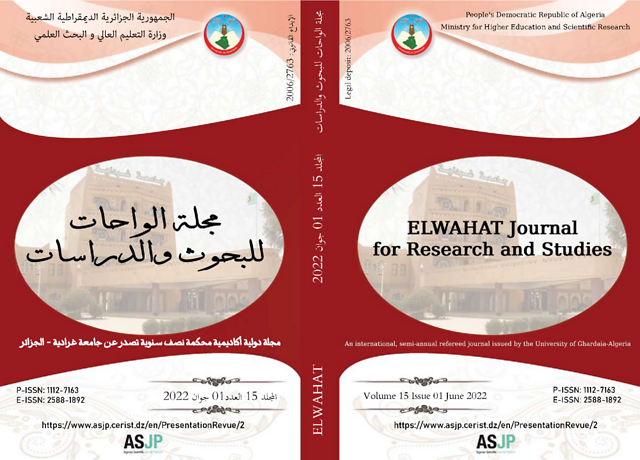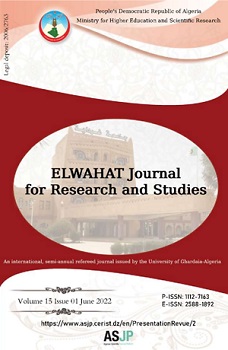الصراعات الجيلية في سياق الوسائط الاتصالية الرقمية استخدامات مواقع التواصل الاجتماعي وعلاقات الآباء- الأبناء المراهقين، مقاربة نظرية
Abstract
ملخص
تهدف هذه الدراسة النّظرية، التّعرض لطبيعة العلاقات النّاشئة بين جيل الآباء وجيل أبنائهم المراهقين الرقميين المستخدمين للوسائط الرقمية والمتمثلة في أكثرها انتشارا بين فئة المراهقين في كل أنحاء العالم، مواقع شبكات التواصل الاجتماعي وخاصة شبكة الفايسبوك، كشبكات تعيد تراتب ونسج علاقاتهم الاجتماعية القديمة/ الجديدة مع آبائهم وأعضاء أسرهم وأقرانهم، وكيفية تأثيرها على وضعية علاقات الصراع، الانسجام، والسلطة بين الآباء وأبنائهم المراهقين الرقميين، ودور الآباء العِلاقاتي التّنشِأَوي. خلصت الدراسة إلى نتائج أهمها؛ جيل المراهقين المعاصرين يوصف بــــ Digital Native للإشارة إلى جيل المستخدم الأصلي الذي كبر مع الكمبيوتر والهواتف النقالة والإنترنت، والذي يعكس اختلاف أساسي في التعامل مع التكنولوجيات الاتصالية الحديثة، ويعيشون نمط حياة علاقاتي مختلف عن نمط حياة جيل آبائهم. قضاء أوقات طويلة في فضاءات مواقع التشبيك الاجتماعي، ونزوع المراهقين نحو الاستقلالية وتأكيد ذواتهم عبرها، من شأنه أن يشكل حركة للصراع الجيلي بين الآباء والأبناء المراهقين نتيجة لتزايد الفجوة الرقمية بين الجيلين. الآباء اليوم هم عرضة للتخلي عن سلطتهم على أبنائهم المراهقين نتيجة لعدم قدرتهم ملاحقة استخداماتهم لتكنولوجيا الاتصال الشبكي وعدم خبرتهم التكنولوجية.
كلمات دالة: مواقع التواصل الاجتماعي، المراهقين المعاصرين، الصّراعات الجيليّة، العلاقات الآباء/ الأبناء المراهقين، الخبرة التّكنولوجيّة.
Abstract
The purpose of this theoretical study is to expose the nature of the emerging relationships between the generation of parents and the generation of their digital adolescent children who use digital media, which is the most prevalent among adolescents in all over the world, social media sites, especially Facebook, as networks that reorder and weave their old / new social relationships with their parents, their family members and their peers, and how it affects the status of conflict relationships, harmony, and authority between fathers and their digital adolescent children, and the sculptural relational role of parents. The study concluded with the most important results: The generation of modern teenagers is described as Digital Native to refer to the generation of the original user who grew up with computers, mobile phones and the Internet, which reflects a fundamental difference in dealing with modern communication technologies, and they live a different relationship lifestyle from that of their parents' generation. Spending long time on social media, and the adolescents' tendency towards independence and asserting themselves through it, would constitute a movement of generational conflict between parents and teens children as a result of the growing digital divide between the two generations. Parents today are prone to give up their authority over their adolescent children as a result of their inability to control their use of networking technology and their technological inexperience.
Keywords: Social networking sites, modern teens, generational conflicts, parent / adolescent relationships, technological expertise.
References
قائمة المراجع باللغة العربية
الكتب
أحمد محمد الزعبي (دس)، سيكولوجية المراهقة، النظريات -جوانب النمو- المشكلات وسبل علاجها، دار زهران للنشر والتوزيع، الأردن.
مواقع الإنترنت
عبد الكريم عبد الله با عبد الله، جيل بين عزلتين...فمن له؟ مسترجع من الموقع: http://islamselect.net، بتاريخ2016-03-01 ، على الساعة 15:40.
سابرينا بار (2019)، إلى أيّ جيل تنتمي؟ الألفية أم الجيلx أو z؟ مسترجع من الموقع: https://www.independentarabia.com، بتاريخ2021-06-03 ، على الساعة 16:40.
ماذا تعرف عن الجيل z؟، مسترجع من الموقع: https://www.arabicpost.net، بتاريخ 03/06/2021، على الساعة 23:00.
أحمد قشطة (2017)، تعرف على الجيلz- الجزء الأول، مسترجع من الموقع: https://www.sasapost.com بتاريخ: 03/06/2021، على الساعة 16:16.
(Harvard Busniess Review ; 2021)، جيل زد Generation Z، مسترجع من الموقع: https://hbrarabic.com، بتاريخ: 03/06/2021، الساعة؛ 14:23.
قائمة المراجع باللغة الأجنبية
الكتب
1- boyd, danah . (2008). Taken Out of Context: American Teen Sociality in Networked Publics. PhD Dissertation. University of California-Berkeley.
School of Information http://www.danah.org/papers/.
2- Christian Balagué et David Fayon. (2010). A quoi sert un réseau social?, Pearson Education, France.
3- Antonovsky, H.; Meria, M.; Blanc, J. (1975). Patterns of Socialization in an Arab Village. Jerusalem: Institute of Applied Social Research.
مقال في مجلة
1- Pierre Mercklé. (2004). les réseaux sociaux, les origines de l’analyse des réseaux sociaux, CNED/ENS-Ish, 2003-2004.
4- . Mélanie Millette. (2009). Usages contributifs sur internet : le podcasting indépendant et le sens de son style, Université du Québec à Montréal.
مواقع الإنترنت
1- Lenhart ARainie LLewis. (2001). O Teenage Life Online: The Rise of the Instant-Message Generation and the Internet's Impact on Friendships and Family Relationships. Washington, DC Pew Internet and American Life Project. مسترجع من الموقع https://www.pewresearch.org/internet/2001/06/21/teenage-life-online/ بتاريخ 24/10/2019
2- Lee WKuo ECY. (2006). Internet and displacement effect: children's media use and activities in Singapore. J Comput MediatCommun;7(2)
https://www.semanticscholar.org/paper/Internet- مسترجع من الموقع and-Displacement-Effect بتاريخ 12/02/2019
3- Subrahmanyam, K., Kraut, R., Greenfield, P. and Gross, E. (2000) The Impact of Home Computer Use on Children’s Activities and Development. The Future of Children and Computer Technology, 10, 123-144. http://dx.doi.org/10.2307/1602692مسترجع من الموقع بتاريخ19/03/2020
4- Wilkinson RB. (2004). The role of parental and peer attachment in the psychological health and self-esteem of adolescents. J Youth Adolesc; vol 33. مسترجع من الموقع https://www.researchgate.net/publication/227160046 بتاريخ 24/10/2019
Carter M, McGee R, Taylor B, Williams S. (2007). Health outcomes in adolescence: associations with family, friends and school engagement. J Adolesc. 2007 Feb;30(1) مسترجع من الموقع https://pubmed.ncbi.nlm.nih.gov/ بتاريخ 24/10/2019
5- Chowhan JStewart JM.. (2007). Television and the behaviour of adolescents: does socio-economic status moderate the link? Soc Sci Med;65 (7).مسترجع من الموقع https://pubmed.ncbi.nlm.nih.gov/ بتاريخ 24/10/2019
6- Moore JHarre N. (2007). Eating and activity: the importance of family and environment. Health Promot J Austr;18 (2). مسترجع من الموقع https://pubmed.ncbi.nlm.nih.gov/ بتاريخ 24/10/2019
7- Lei Lwu Y. (2007). Adolescents' paternal attachment and Internet use. Cyberpsychol Behav;10 (5). مسترجع من الموقع https://www.liebertpub.com/doi/10.1089/cpb.2007.9976: بتاريخ 24/10/2019
8- Lenhart A., Hitlin P., Madden M. (2005). Teens and technology. مسترجع من الموقع http://www.pewinternet.org/Reports/2005/Teens-and-Technology.aspx/ بتاريخ 14/08/2018
13- Sanders CEField TMDiego MKaplan M. (2000). The relationship of Internet use to depression and social isolation among adolescents. Adolescence; 35 (138) مسترجع من الموقع https://pubmed.ncbi.nlm.nih.gov / بتاريخ 24/10/2019
10- Anne C. Fletcher, Bethany L. Blair. (2014). Maternal Authority Regarding Early Adolescents’ Social Technology Use, Journal of Family Issues, vol. 35 no. 1 , USA.
مسترجع من الموقع https://pubmed.ncbi.nlm.nih.gov / بتاريخ 24/10/2019






